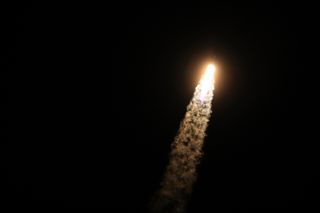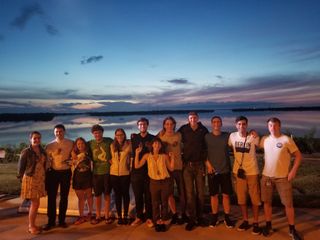Students Send Human Spit, Baby Teeth and More to Space … for Science

Glass beads, broccoli, severed worms, baby teeth and a whole lot of human spit are flying in space as part of student-designed experiments.
On June 29, students watched as the experiments they designed and built soared into the predawn Florida sky on their way to the International Space Station. The experiments launched aboard a SpaceX Dragon cargo ship on the CRS-15 cargo delivery mission for NASA, and the Dragon arrived at the space station this week.
The students were led by DreamUp, an organization that aims "to bring space into the classroom and the classroom into space," according to its website. The project involved students from four continents for this launch, as it aims to be inclusive, Carie Lemack, co-founder and CEO of DreamUp, told Space.com. [In Photos: SpaceX's Dazzling Dragon Launch to Space Station]
The participating students designed their experiments entirely on their own, and the concepts they came up with are both applicable to the real world and extremely creative, Lemack said.
One student team, from the Student Spaceflight Experiments Program (SSEP), a U.S.-based initiative, sent up a particularly unique experiment. Their study will examine how saliva decays teeth and how penicillin acts in microgravity, according to a statement emailed to Space.com.
For this experiment, the students had to mix a tooth with saliva. The group used real human baby teeth from one student, whose mom had saved them, according to Lemack. To prepare enough saliva to both send into space and use for the comparison experiment on Earth, the team also had to collect a lot of saliva. To achieve this, one student "spent 20 minutes spitting into a cup," Lemack said.
Other experiments from SSEP student teams will investigate how a variety of plant seeds, including carrot seeds and kudzu seeds, germinate in microgravity; how broccoli grows in microgravity; how brine shrimp eggs hatch in microgravity; and how planarian worms, whose tails the students cut off, will regrow their tails in space.
Get the Space.com Newsletter
Breaking space news, the latest updates on rocket launches, skywatching events and more!
In another experiment, KSat e. V., a small student group at the University of Stuttgart in Germany, sent up a project called Pumped Application using Pulsed Electromagnets for Liquid relocation (PAPELL). This experiment will explore the pumping of ferrofluids, or liquids that become highly magnetized in the presence of a magnetic field, in microgravity, according to thestatement.

Another experiment, Planet Formation Due to Charge Induced Clusters on ISS (ARISE), was sent up by a student group from the University of Duisburg-Essen in Germany. ARISE and PAPELL were two of the three winners of the Überflieger contest, which was held in partnership with the German Aerospace Center. This experiment will use colliding glass beads to investigate the role of electrically charged particles in the creation of new cosmic objects, according to the statement.
While the astronauts aboard the space station conduct these experiments in microgravity, the students will do experiments on Earth to serve as comparisons to the results in microgravity. When SpaceX's Dragon capsule returns to Earth 30 days after launch, the students will be able to compare their results and analyze the findings, Lemack said.
Email Chelsea Gohd at cgohd@space.com or follow her @chelsea_gohd. Follow us @Spacedotcom, Facebook and Google+. Original article on Space.com.
Join our Space Forums to keep talking space on the latest missions, night sky and more! And if you have a news tip, correction or comment, let us know at: community@space.com.

Chelsea “Foxanne” Gohd joined Space.com in 2018 and is now a Senior Writer, writing about everything from climate change to planetary science and human spaceflight in both articles and on-camera in videos. With a degree in Public Health and biological sciences, Chelsea has written and worked for institutions including the American Museum of Natural History, Scientific American, Discover Magazine Blog, Astronomy Magazine and Live Science. When not writing, editing or filming something space-y, Chelsea "Foxanne" Gohd is writing music and performing as Foxanne, even launching a song to space in 2021 with Inspiration4. You can follow her on Twitter @chelsea_gohd and @foxannemusic.
